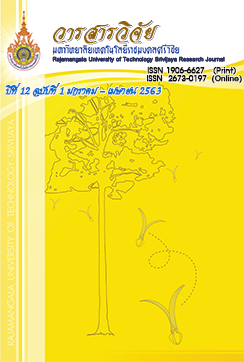Modification of Dietary Fiber from Cassava Pulp to Reduce Heavy Metal by Assessing Their Heavy Metal Bioaccessibility Inhibition
คำสำคัญ:
กากมันสำปะหลัง, ใยอาหาร, การดัดแปลงใยอาหาร, ชีวภาพพร้อมใช้, โลหะหนักบทคัดย่อ
การศึกษานี้มีวัตถุประสงค์เพื่อหาวิธีที่เหมาะสมในการดัดแปลงใยอาหารจากกากมันสำปะหลังและผลต่อการยับยั้งชีวภาพพร้อมใช้ในโลหะหนัก การเตรียม MDF (ใยอาหารดัดแปลง) จากกากมันสำปะหลังเริ่มจากการแยกแป้งและโปรตีนด้วยเอนไซม์เพื่อเตรียมใยอาหารหยาบ (CDF) ด้วยแอลฟาอะมัยเลส 1% (w/v) อะมัยโลกลูโคซิเดส 0.1% (v/v) และ นิวเทรส 1% (v/v) จากนั้นดัดแปลง CDF ด้วย 4 วิธี ได้แก่ วิธีเอสเทอริฟิเคชั่น ฮาโลจีเนชั่น ออกซิเดชันและอีเทอริฟิเคชั่น ผลการทดลองพบว่าการดัดแปลง CDF สามารถปรับปรุงคุณสมบัติในการจับกับโลหะหนักได้ โดย MDF มีปริมาณ neutral detergent fiber (NDF) acid detergent fiber (ADF) acid detergent lignin (ADL) เซลลูโลส เฮมิเซลลูโลส โปรตีน ไขมัน ความชื้นและแป้งมากกว่าใน CDF นอกจากนี้คุณสมบัติเชิงหน้าที่ของ MDF มีค่าความสามารถในการอุ้มน้ำ ความสามารถในการจับกับน้ำมัน ความสามารถในการละลายน้ำ ค่าการพองตัว และกลุ่มคาบอกซิลมากกว่า CDF
นอกจากนั้นศึกษาผลของ MDF จาก 4 วิธี ต่อชีวภาพพร้อมใช้ของตะกั่วด้วยแบบจำลองการย่อยอาหาร พบว่า MDF จากทุกวิธีสามารถลดชีวภาพพร้อมใช้ของตะกั่วได้อย่างมีนัยสำคัญทางสถิติเมื่อใช้ MDF ปริมาณ 0-1000 mg (p < 0.05) โดยลดลง 25-80% ที่ 1000 mg ให้ผลดีที่สุด และ MDF จากวิธีอีเทอริฟิเคชั่นสามารถยับยั้งได้ดีกว่าวิธีอื่นอย่างมีนัยสำคัญทางสถิติ (p < 0.05) ในทุกระดับของใยอาหารที่ใช้ จึงสรุปได้ว่า MDF ที่ได้จากการดัดแปลงด้วยวิธีอีเทอริฟิเคชั่นสามารถลดชีวภาพพร้อมใช้ของตะกั่ว และสามารถนำมาประยุกต์ใช้ในผลิตภัณฑ์อาหารเสริมและผลิตภัณฑ์เสริมอาหารได้
เอกสารอ้างอิง
Aoki, N., Fukushima, K., Kurakata, H., Sakamoto, M. and Furuhata, K. 1999. 6 Deoxy-6-mercaptocellulose and its S-substituted derivatives as sorbents for metal ions. Reactive and Functional Polymers 42(3): 223-233.
Barbier, O., Jacquillet, G., Tauc, M., Cougnon, M. and Poujeol, P. 2005. Effect of heavy metals on, and handling by, the kidney. Nephron Physiology 99: 105-110.
Bahemuk, T.E. and Mubofu, E.B. 1999. Heavy metals in edible green vegetables grown along the sites of the Sinza and Msimbazi rivers in Dares Salaam, Tanzania. Food Chemistry 66(1): 63-66.
Caprez, A., Arrigoni, E., Amado, R. and Neukom, H. 1986. Influence of different type of thermal treatment on chemical composition and physical properties of wheat bran. Journal of Cereal Science 4(3): 233-239.
Courraud, J., Berger, J., Cristol, J.P. and Avallone, S. 2013. Stability and bioaccessibility of different forms of carotenoids and vitamin A during in vitro digestion. Food Chemistry 136(2): 871-877.
Doczekalska, B., Bartkowiak, M. and Zakrzewski, R. 2014. Esterification of willow woodwith cyclic acid anhydrides. Wood Research 59(1): 85-96.
Eastwood, M.A. and Morris, E.R. 1992. Physical properties of dietary fiber that influence physiological function: a model for polymers along the gastrointestinal tract. The American Journal of Clinical Nutrition 55(2): 436-442.
Fu, J.J., Zhou, Q.F., Liu, J.M., Liu, W., Wang, T., Zhang, Q.H. and Jiang, G.B. 2008. High levels of heavy metals in rice (Oryza sativa L.) from a typical E- will bete recycling area in southeast China and its potential risk to human health. Chemosphere 71(7): 1269-1275.
Garrett, D.A., Failla, M.L. and Sarama, R.J. 1999. Development of an in vitro digestion method to assess carotenoid bioavailability from meals. Journal of Agriculture and Food Chemistry 47: 4301-4309.
Hu, G., Huang, S., Chen, H. and Wang, F. 2010. Binding of four heavy metals to hemicelluloses from rice bran. Food Research International 43(1): 203-206.
Huang, M.L., Zhou, S.L., Sun, B. and Zhao, Q.G. 2008. Heavy metals in wheat grain: assessment of potential health risk for inhabitants in Kunshan. Science of the Total Environmental 405(1-3): 54-61.
Jasberg, B.K., Gould, J.M., Warner, K. and Navickis, L. 1989. High-fiber, noncaloric flour substitute for baked foods. Effects of alkaline peroxide treated lignocellulose on dough properties. Cereal Chemistry 66(3): 205-209.
Kachenpukdee, N., Santerre, C.R., Ferruzzi, M.G. and Oonsivilai, R. 2016. Enzymatic digestion optimization of dietary fiber from cassava pulp and their effect on mercury bioaccessibility and intestinal uptake from fish using an in vitro digestion/Caco-2 model. International Food Research Journal 23(2): 660-666.
Khan, S., Khan, I., Hussain, I., Khan, B.M. and Akhtar, N. 2008. Profile of heavy metals in selected medicinal plants. Pakistan journal of weed science research 14(1-2): 101-110.
Kosugi, A., Kondo, A., Ueda, M., Murata, Y., Vaithanomas, P., Thanapase, W., Arai, T. and Mori, Y. 2009. Production of ethanol from cassava pulp fermentation with a surface engineered yeast strain Inst. displaying glucoamylase. Renewable Energy 34(5):1354-1358.
Mertens, D.R. 1987. Predicting intake and digestibility using mathematical models of ruminal function. The Journal of Animal Science 64(5): 1548-58.
Nawirska, A. 2005. Binding of heavy metals to pomace fibres. Food Chemistry 90(3): 395-400.
O’Connell, D.W., Birkinshaw, C. and O’Dwyer, T.F. 2008. Heavy metal adsorbents prepared from the modification of cellulose: A review. Bioresource Technology 99(15): 6709-6724.
Robertson, J.A., de Monredon, F.D., Dysseler, P., Guillon, F., Amado, R. and Thibault, J.F. 1999. Hydration properties of dietary fibre and resistant starch. A European collaborative study. LWT-Food Science and Technology 33(2): 72-79.
Sabolic, I. 2006. Common mechanisms in nephropathy induced by toxic metals. Nephron Physiology 104(3):107-114.
Saliba, R., Gauthier, H., Gauthier, R. and Petit Ramel, M. 2000. Adsorption of copper (II) and chromium (III) ions onto amidoximated cellulose. Journal of Applied Polymer Science 75(13): 1624-1631.
Torres-Escribano, S., Vélez, D. and Montoro, R. 2010. Mercury and methylmercurybioaccessibility in swordfish. Food Additives and Contaminants 27(3): 327-337.
United States Pharmacopeia. 1995. Oxidized cellulose and oxidized-regenerated cellulose, pp. 318-319. In Rockville, M.D., ed. United States Pharmacopeia/National Formulary. United States Pharmacopeial Convention Inc, United States.
Van Soest, P.V., Robertson, J. and Lewis, B. 1991. Methods for dietary fiber, neutral detergent fiber, and nonstarch polysaccharides in relation to animal nutrition. Journal of Dairy Science 74(10): 3583-3597.
Wang, Y.B., Gou, X., Su, Y.B. and Wang, G. 2006. Risk assessment of heavy metals in soils and vegetables around Li, Y., non-ferrous metals minin. g and smelting sites. Journal of Environmental Sciences 18(6): 1124-1134.
Zhuang, P., Zou, H.L. and Shu, W.S. 2009. Biotransfer of heavy metals along a soil-plant-Insect-chicken food chain: field study. Journal of Environmental Sciences 21(60): 849-853.
Zhang, N., Huang, C. and Ou, S. 2011. In vitro binding capacities of three dietary fibers and their mixture for four toxic elements, cholesterol, and bile acid. Journal of Hazardous Materials 186(1): 236-239.
ดาวน์โหลด
เผยแพร่แล้ว
รูปแบบการอ้างอิง
ฉบับ
ประเภทบทความ
สัญญาอนุญาต
เนื้อหาและข้อมูลในบทความที่ลงตีพิมพ์ในวารสารวิจัยมหาวิทยาลัยเทคโนโลยีราชมงคลศรีวิชัย ถือเป็นข้อคิดเห็นและความรับผิดชอบของผู้เขียนบทความโดยตรง ซึ่งกองบรรณาธิการวารสารไม่จำเป็น ต้องเห็นด้วย หรือร่วมรับผิดชอบใดๆ
บทความ ข้อมูล เนื้อหา รูปภาพฯลฯ ที่ได้รับการตีพิมพ์ในวารสารวิจัย มหาวิทยาลัยเทคโนโลยีราชมงคลศรีวิชัย ถือเป็นลิขสิทธ์ของวารสารวิจัย มหาวิทยาลัยเทคโนโลยีราชมงคลศรีวิชัย หากบุคคลหรือหน่วยงานใดต้องการนำทั้งหมดหรือส่วนหนึ่งส่วนใดไปเผยแพร่ต่อหรือเพื่อการกระทำการใดๆจะต้องได้รับอนุญาตเป็นลายลักษ์อักษรจากวารสาร มหาวิทยาลัยเทคโนโลยีราชมงคลศรีวิชัยก่อนเท่านั้น







